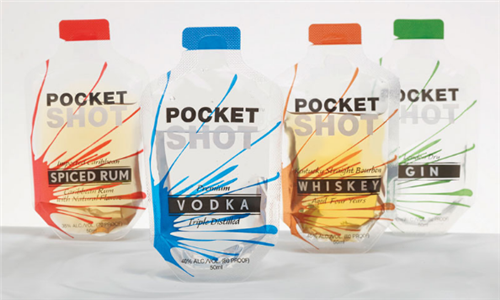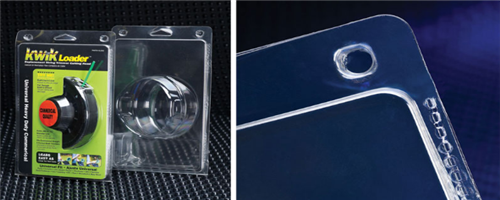
Ultrasonic' New Packaging Options
Ultrasonic' New Packaging Options
Here are several examples that illustrate how ultrasonic technology is playing a critical role in the success of product packaging design for manufacturers, points-of-sale outlets, and consumers alike.
Beverages in flexible, multi-layer film packages. Pocket Shot Spirits developed an unbreakable easy-open, pocket-size “bottle” of spirits for on-the-go travelers, golfers, and ports and outdoor enthusiasts. But sealing the 50-ml flexible plastic pouches with a combination heat-seal, cold-seal process proved inconsistent at high production speeds, resulting in leaks that reduced process yields.
So, Pocket Shot considered ultrasonic sealing. Ultimately, an ultrasonic horn-anvil combination was developed using FEA software that precisely matched the contoured sealing surfaces at the top of the Pocket Shot package. The ultrasonic process sealed through the top of the three-layer film package despite the presence of alcoholic residues.
At the same time, the process supported production speeds of up to 35 packages/min. with high repeatability. The ultrasonic action of the horn disperses the alcohol out of the seal area and lets the plastic melt without the risk of triggering the flashpoint of alcohol.

Recycled PET clamshell packages. To meet regulatory requirements, Kwik, a company that makes outdoor products, decided to retire its clear, tamper-resistant PVC clamshell packages in favor of recycled PET packages. It also wanted to continue using its already installed base of ultrasonic welding equipment. But RPET proved far more difficult to weld with conventional ultrasonic, leading to melt-through or cracking. A customized horn-anvil combination, together with an innovative stitch-weld design, fixed the problem. The finished machine produced weld seams stronger than the RPET packaging material.

On-the-go dispensing packages. Hikers and outdoor enthusiasts eat a lot of nutritious nut-butter products, but typical product jars and lids are heavy, make it difficult to spread their contents on crackers and bread when on-the-go. Yumbutter designed a lightweight, squeezable plastic pouch that eliminated the need for lids, jars, and even utensils. However, oily product residue trapped in the package’s heat seals led to leaks, throwing the viability of the innovative package into question.
Ultrasonic seals saved the package design. Their high-frequency vibration displaced foods and contaminants from sealing surfaces before bonding them together. To demonstrate the package’s durability for the outdoors, Yumbutter founder Adrian Reif says, “We actually use a ‘stand’ test at the end of line, and literally stand on selected packages to ensure a quality seal. There have been no failures.”

From the time thermoplastic films were first developed, they have made heat sealing a mainstay for packaging designers. It has been adapted widely for sealing everything from thin-wall food and snack bags to clamshell packages for hardware, electronics, and many other applications. But as heat-sealing technology has matured and packaging materials have evolved, package designers have come to recognize some limitations in this common and widely used packaging method.
© Copyright: 2024 Hangzhou Altrasonic Technology Co.,Ltd All Rights Reserved

IPv6 network supported
Scan to WhatsApp
